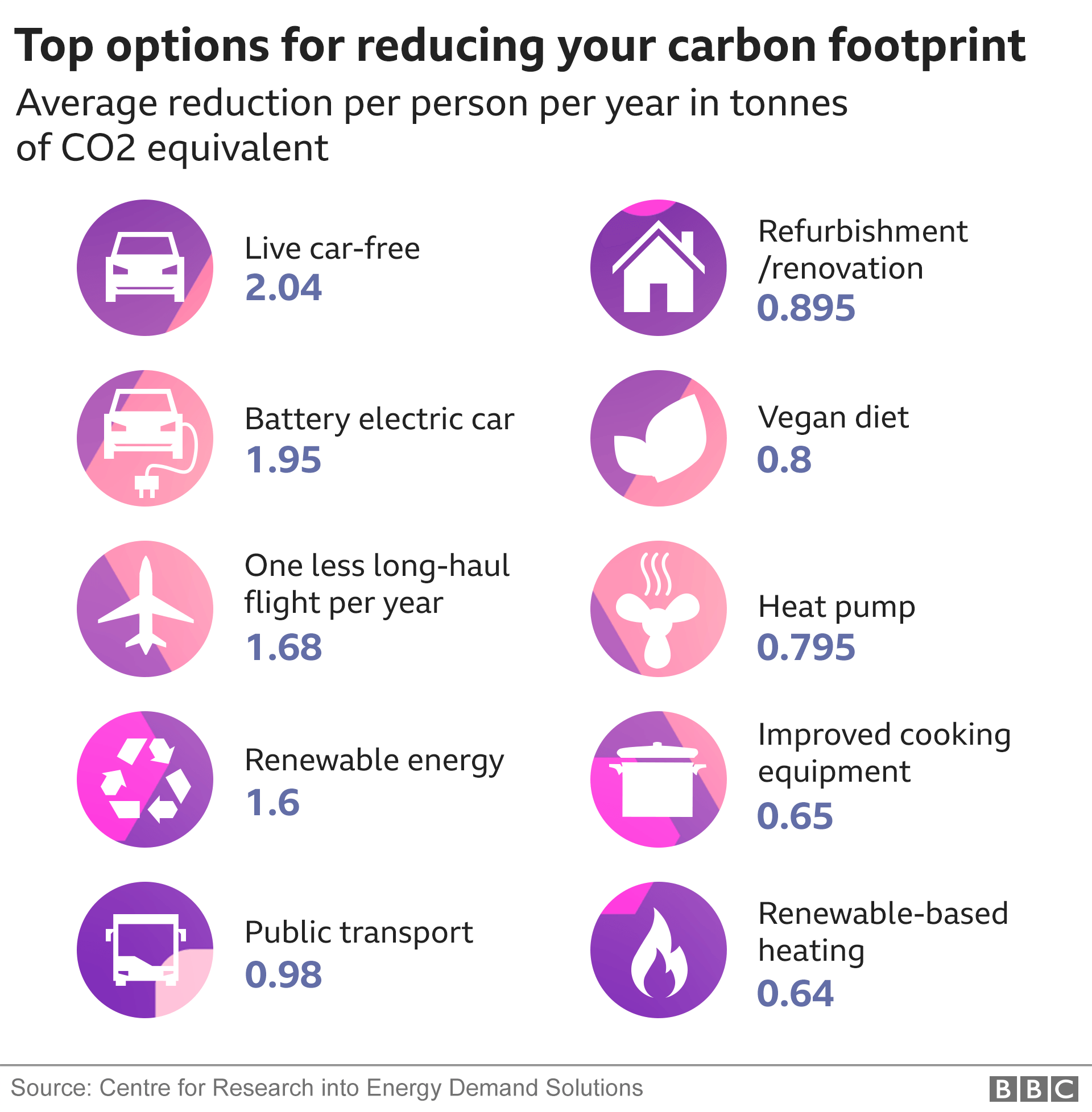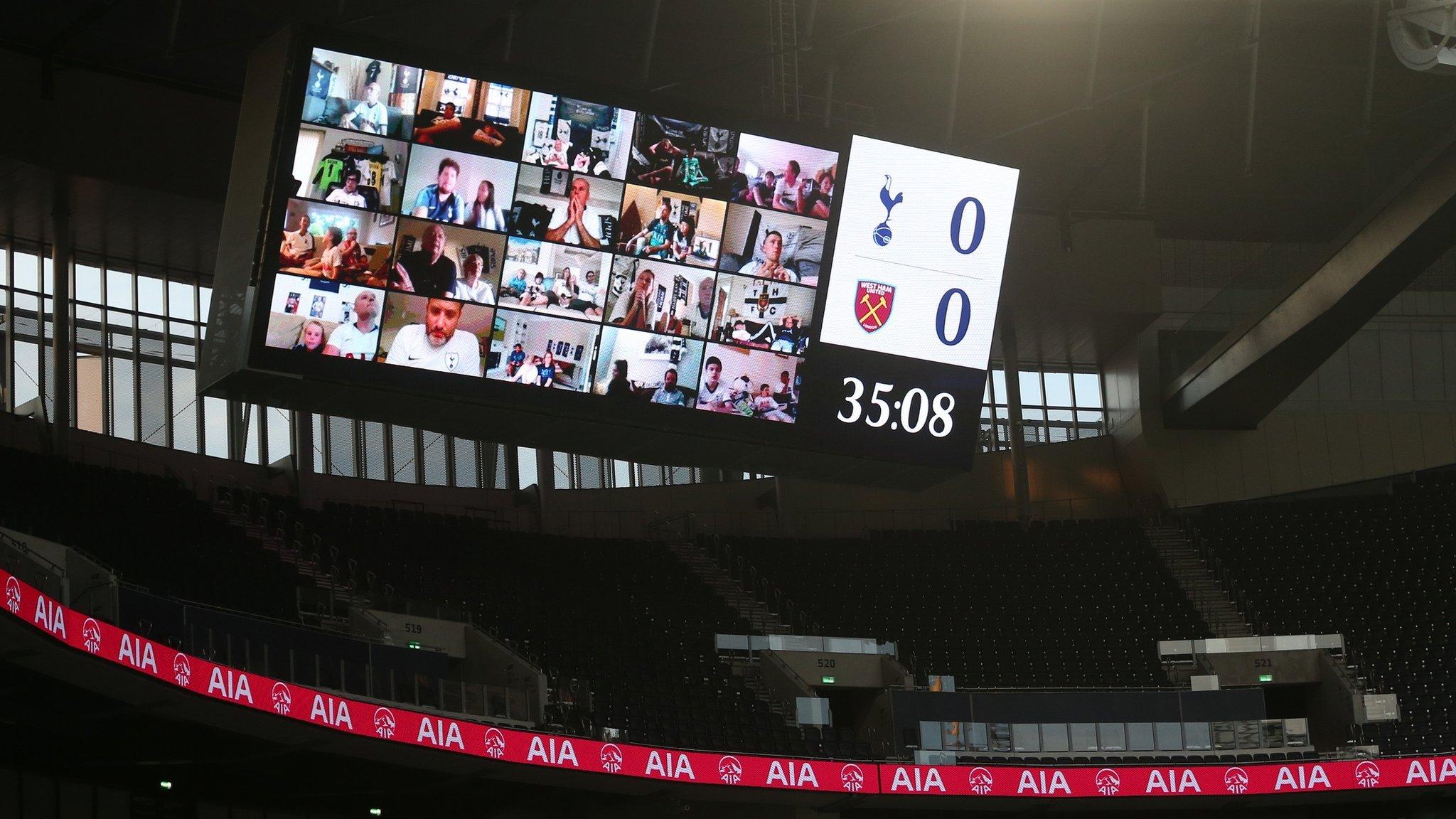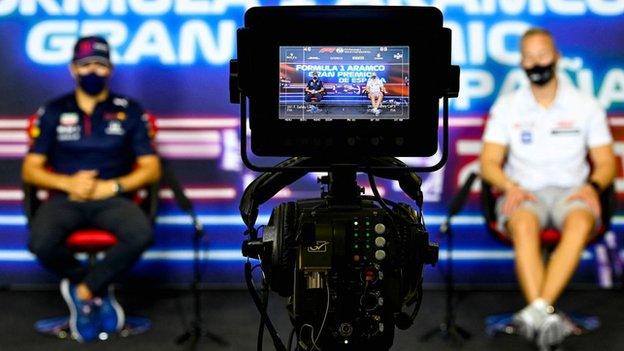Sport 2050: Three ways attending sport as a fan could change
- Published

Masked fans watch baseball in 2021
Being a sports fan in 2020 and 2021 has been a very different experience.
Fast forward to 2050, and there are a number of other factors that will likely create further dramatic changes in the world - resulting in the sports fan's matchday experience looking very different in 30 years' time.
Here are a few ways the fan experience may change.
No more quick trips to Europe on budget airlines
It is widely recognised by researchers and major sport organisations that one of the biggest environmental impacts from sport is related to travelling fans going to games.
This is especially the case for large scale mega-events, such as football World Cups or the Olympics, which typically require masses of fans to fly vast distances in order to cheer on their favourite teams.
In order to reduce carbon emissions, travel to sporting events may be required to use more ecologically friendly over-land travel, or could potentially even restrict attendees to those who live within a certain geographic region.
Of course, the coronavirus pandemic has potentially brought us closer to experiencing what sport may look like in 2050, as organisers of the Tokyo Olympic Games have already made the decision to ban spectators from overseas from attending the games.
For those events that do allow travel, the experience will be a different one that will likely take longer, and become more of a pilgrimage as masses travel together slowly to cheer on their favourite teams.

Some organisations may become more involved with various aspects of fan travel to make it more environmentally friendly, with more clubs providing incentives for fans to use public transport to travel, such as in Germany where match tickets for teams such as Schalke and Dusseldorf also cover the fare for use of local buses and trains on the same day.
At another level, large football clubs may even start subsidising or offering travel to both domestic and international matches using environmentally friendly transportation, such as electric buses as another way to reduce the carbon footprint of fan travel.
You might not have to physically be at the match, to be part of the match…

Virtual supporters watch a game on the big screen at Tottenham Hotspur's ground during the Covid-19 pandemic
If sporting events do begin to restrict attendance to only individuals in certain regions, then it will become important for sport organisations to find other ways to create interactive experiences with fans.
Technology will play a critical role in helping fans to connect with their favourite teams and players, and to feel like they are at a sporting event.
Turning again to examples from the Covid pandemic, sport organisations have used video software to have fans interacting with events, and even players in some instances.
For example, the NBA used a video wall of fans cheering during games while it was playing in a quarantine bubble, allowing fans to not only continue to be part of the game-day experience, but also see themselves on television during broadcasts.
Likewise, during the pandemic when fans were excluded from races, Formula 1 utilised video technology to allow fans to not only see their favourite drivers arriving at races, but also to interact with them by cheering, asking questions, and even asking drivers to dance for them.

All F1 news conferences and fan interaction have been done via video this season
Although video technology has been beneficial for sport organisations to help fans stay connected with their favourite teams and athletes, by 2050 technology will likely also offer a more immersive experience.
Through the use of interactive virtual reality, individuals will not only be able to experience sporting events as though they were actually there in-person, but in some cases may even get to complete.
For example, golf competitions will not only offer the ability for individuals to view the course from the perspective of the players, but will also provide an interactive element where fans are able to attempt to play the same course and shots the professionals on the course are attempting.
In some instances, sport competitions could take this immersive experience to a new level, allowing those fans with the best scores, whether they be golfers, swimmers, runners etc, to qualify for future competitions.
What about the fans in the stadium?

Stadiums will be fully air conditioned in Qatar 2022
Finally, for those who are lucky enough to make it into a venue to watch a sporting event, how will the in-game experience change by 2050?
For one, the traditional game-day experiences, such as a pre-match pint or 'tailgating' in America, where fans cook food and socialise in the parking lot before games, will likely see changes that become more environmentally friendly.
For example, rather than relying on gas hobs in pub restaurants, charcoal grills for cooking or generators for powering electronic devices, sport organisations will likely begin to offer fans the access to grills and a power grid that uses clean energy to minimise the environmental impact of these mass activities.
Upon entering the venue, there will also be changes to help enhance the experience of fans attending games.
First off, more stadiums will either be enclosed domes to protect fans from extreme weather conditions, especially the heat.

For a day out at the ball game in the United States, many fans will 'tailgate' before the match. This involves fans meeting in car parks for a barbeque. But it arguably needs to become a much more environmentally friendly event by 2050
However, as building a domed stadium or having air conditioning in every seat, as has been done in the venues for the Fifa 2022 World Cup in Qatar, is cost prohibitive, there will be other measures that teams and sport competitions will need to take.
For those stadiums that must deal with heat issues, there will be new measures to protect fans, including an increased number of hydration stations, vendors offering cold drinks and ice packs, and even enclosed concourses that provide fans with areas to be able to cool off.
Moreover, it may be likely that as sport contests incorporate more heat breaks during games to protect players, stadiums will also begin to ask fans to move into the cooled concourses as well to protect themselves from the heat as well.
Dr Nick Watanabe is associate professor, Sports and Entertainment Management at the University of South Carolina